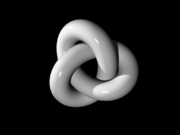Homeomorphism
2008/9 Schools Wikipedia Selection. Related subjects: Mathematics

In the mathematical field of topology, a homeomorphism or topological isomorphism (from the Greek words homoios = similar and μορφή (morphē) = shape = form (Latin deformation of morphe)) is a special isomorphism between topological spaces which respects topological properties. Two spaces with a homeomorphism between them are called homeomorphic. From a topological viewpoint they are the same.
Roughly speaking, a topological space is a geometric object, and the homeomorphism is a continuous stretching and bending of the object into a new shape. Thus, a square and a circle are homeomorphic to each other, but a sphere and a donut are not. An often-repeated joke is that topologists can't tell the coffee cup from which they are drinking from the donut they are eating, since a sufficiently pliable donut could be reshaped to the form of a coffee cup by creating a dimple and progressively enlarging it, while shrinking the hole into a handle.
Intuitively, a homeomorphism maps points in the first object that are "close together" to points in the second object that are close together, and points in the first object that are not close together to points in the second object that are not close together. Topology is the study of those properties of objects that do not change when homeomorphisms are applied.
Definition
A function f between two topological spaces X and Y is called a homeomorphism if it has the following properties:
- f is a bijection ( 1-1 and onto),
- f is continuous,
- the inverse function f −1 is continuous (f is an open mapping).
If such a function exists, we say X and Y are homeomorphic. A self-homeomorphism is a homeomorphism of a topological space and itself. The homeomorphisms form an equivalence relation on the class of all topological spaces. The resulting equivalence classes are called homeomorphism classes.
Examples

- The unit 2- disc D2 and the unit square in R2 are homeomorphic.
- The open interval (−1, 1) is homeomorphic to the real numbers R.
- Every uniform isomorphism and isometric isomorphism is a homeomorphism.
- Any 2-sphere with a single point removed is homeomorphic to the set of all points in R2 (a 2-dimensional plane).
 and
and  are not homeomorphic for
are not homeomorphic for 
Properties
- Two homeomorphic spaces share the same topological properties. For example, if one of them is compact, then the other is as well; if one of them is connected, then the other is as well; if one of them is Hausdorff, then the other is as well; their homology groups will coincide. Note however that this does not extend to properties defined via a metric; there are metric spaces which are homeomorphic even though one of them is complete and the other is not.
- A homeomorphism is simultaneously an open mapping and a closed mapping, that is it maps open sets to open sets and closed sets to closed sets.
- Every self-homeomorphism in S1 can be extended to a self-homeomorphism of the whole disk D2 ( Alexander's Trick).
Informal discussion
The intuitive criterion of stretching, bending, cutting and gluing back together takes a certain amount of practice to apply correctly — it may not be obvious from the description above that deforming a line segment to a point is impermissible, for instance. It is thus important to realize that it is the formal definition given above that counts.
This characterization of a homeomorphism often leads to confusion with the concept of homotopy, which is actually defined as a continuous deformation, but from one function to another, rather than one space to another. In the case of a homeomorphism, envisioning a continuous deformation is a mental tool for keeping track of which points on space X correspond to which points on Y — one just follows them as X deforms. In the case of homotopy, the continuous deformation from one map to the other is of the essence, and it is also less restrictive, since none of the maps involved need to be one-to-one or onto. Homotopy does lead to a relation on spaces: homotopy equivalence.
There is a name for the kind of deformation involved in visualizing a homeomorphism. It is (except when cutting and regluing are required) an isotopy between the identity map on X and the homeomorphism from X to Y.